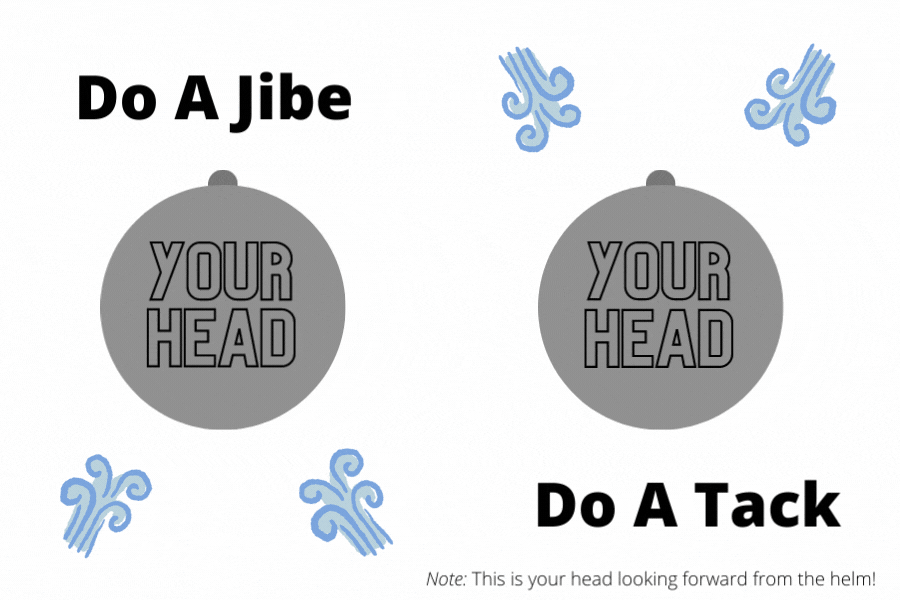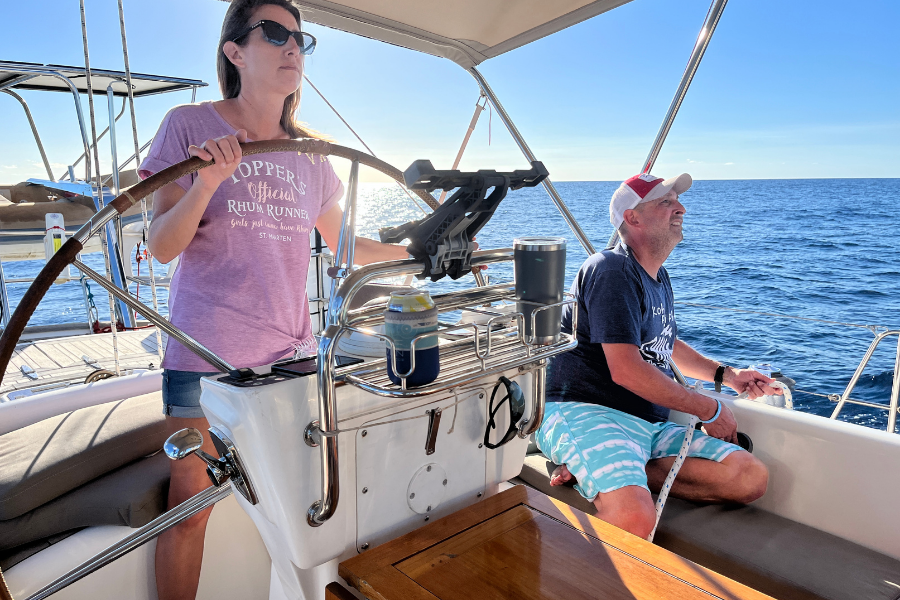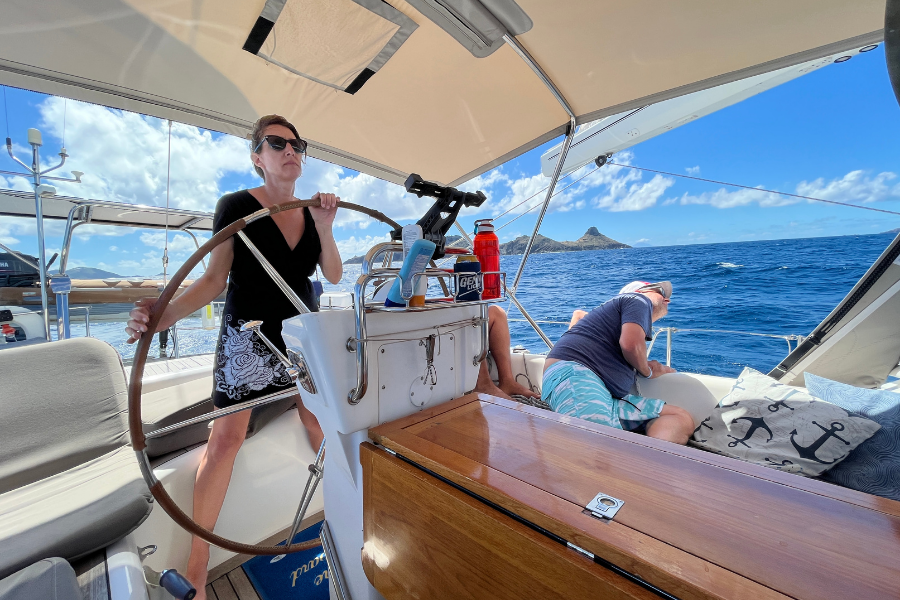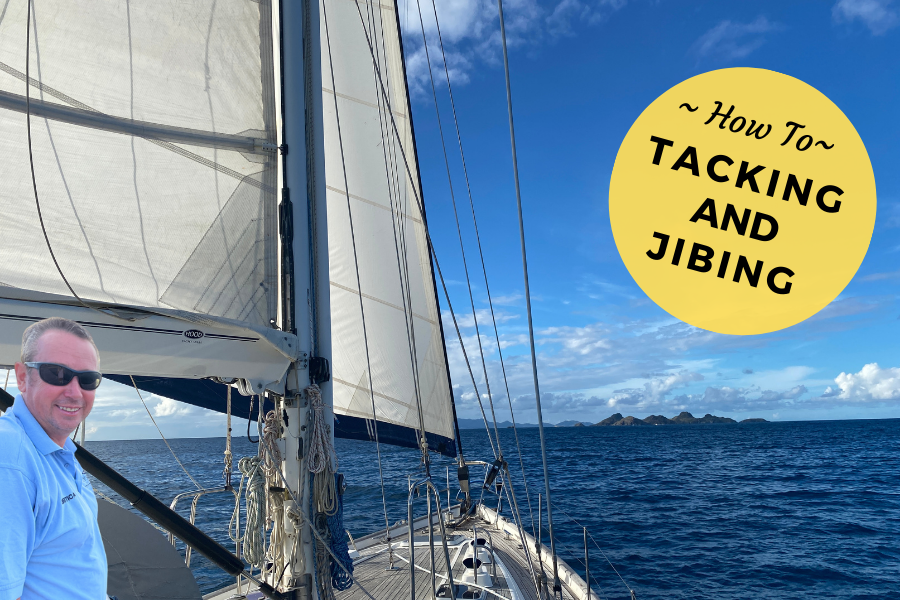Did you know that one of the biggest hurdles new sailors have is to easily grasp the concept of tacking and jibing (US) / gybing (UK)? It might sound crazy because to tack or to jibe simply means to turn the boat left or right. How can that be so complicated?
Well, tacking and jibing is not as simple as it seems.
First, you have to determine whether you’re going to do a tack or a jibe and that depends on where the wind is coming from. Next, there is one procedure for tacking and a more involved procedure for jibing. Furthermore, it’s not uncommon for new sailors to accidentally jibe and that can be a disaster.
Keep reading and I will demystify the whole process. By the time you’re done reading this article, you’ll know when to tack, when to jibe, how to prepare for each, and most importantly, how to avoid jibing accidentally!
If you’re going to make a 90-degree turn, right or left, and the wind is hitting any part of your face while looking forward, you’re going to tack. If you’re going to make a 90-degree turn and the wind is hitting any part of the back of your head as you look forward, you’re going to do a jibe.

To tack, the basic procedure is as follows.
The helmsperson announces that he/she wants to tack or make a turn left/right. The crew prepares for the tack (or turn) by getting ready to move the line that holds the headsail from one side of the boat to the other. As the helmsperson turns, the line holding the sail out on one side of the boat is released and the line on the other side is pulled in and secured. As the line changes sides, the sail flops over to the other side.
For the most part, the mainsail just follows along and slowly flops over to the other side without anyone touching it.
Tacks are relatively easy and calm. When tacking, the boat is turning into, or through, the wind. You’re going against the forces until you make your turn and the sails become active again.

What is the difference for jibing then?
Well, when you jibe the wind is PUSHING the boat and sails. You’re not going into or against the wind but the opposite…the wind is sitting there ready and blowing.
So, what this means is that when the helmsperson jibes, left or right, the force of wind behind the boat is going to make things happen very quickly and powerfully. In large cruising sailboats the force can be tremendous. If doing an accidental jibe, or failing to prepare correctly, the whole rig (boom, mast, shrouds) can be compromised.
What happens when the boat accidentally jibes?
The force of the wind that is blowing from behind the boat gets on the wrong side of the sails and causes the sail(s) to fly over to the other side and the boom goes swinging and crashing over. It’s dangerous because the boom can hit someone. Further, it can severely damage the rigging. The power and shock of the crash can break things!
When sailing downwind, with the wind hitting the back of your head, your sails will be out and billowy. Your headsail might be wallowing a bit in the wind and the mainsail will be pushed way out to catch as much wind as possible. With the sails being so far out an accidental jibe will cause everything to crash to the other side. You can see why it’s something to be avoided – yes?

So, there are three things to cover in the jibe section of tacking and jibing.
One is how to properly prepare for a jibe. The second is how to prevent an accidental jibe from happening. And finally, there’s the small little point that no one ever seems to mention – you actually don’t ever have to jibe if you don’t want to!
1. Let’s start with how to prepare for the jibe.
To prepare for a jibe, (the wind is hitting the back of your head – yes?!) you’ll want to pull the mainsail in tight so that when the wind gets on the other side of it the movement is minimal.
Next, you can reduce the headsail by winding it in (furling it) a bit. Once you’re ready, the helmsperson and crew can turn the boat (wind is pushing the stern), one line is released on the headsail while the line on the other side is brought in and fastened.
Once the jibe is over, you then let the headsail and the mainsail back out.
2. And what about preventing an accidental jibe?
First of all, it’s important to understand when it might happen. When you’re sailing along, and the wind is hitting any point of the back of your head it’s important to be on guard. Accidental jibes happen when you’re on the cusp of the wind coming from the back right and going to the back left of your head.
But let me back up and explain sailing dead downwind first.
If the wind is coming directly from behind you it’s not an ideal situation. First of all, your mainsail will get all the wind and your headsail will deflate. (Yes, you can goosewing, but we’re not going into that for now).
Also, when the boat is dead downwind if you have the boom way out and you make one wrong move, or a wave causes the sail to wobble over, that sail is going to catch the wind on the wrong side and the boom is going crash. No Bueno at all.
To be safe, sailors sail either to the left or right back quadrant ensuring that both sails are filled. It might take longer to get to where you’re going, but it’s safer and a better sail. If we get anywhere near dead downwind it’s panic stations for me!

Back to preventing a jibe.
So, the first thing you need to do is to always keep the wind either in one back quadrant or the other. The second thing you can do is to set up a preventer. A preventer is a line that you attach to the boom and back to the boat to prevent the boom from crashing over to the other side. Whenever we’re sailing downwind we always put a preventer on.
Note to self: Make a note to yourself that when you hire a professional to teach you how to sail, maintain, and service your own boat that you make sure they show you how to rig a preventer!
3. And the last thing I want to cover today is the fact that you actually don’t ever have to jibe.
On Britican, when it’s just me and Simon we rarely jibe. The only reason we jibe nowadays is because we are teaching people how to jibe.
So…instead of doing a 90-degree turn, we do a 270-ish degree turn. Let’s say the wind is hitting the back right side of my head, sails are off to the left side, and I want to turn left. The normal thing to do would be to prepare for a jibe and turn left 90 degrees.
OR, I could turn right, into the wind 270 degrees making it a tack. Instead of the wind pushing you around, you’re turning the boat more and more into the wind making it a tack. The longer you cruise, the lazier I think you get. Hehehehe.
One thing to note, however, is that if the mainsail is way out on either side, whether you’re tacking or Jibing, it’s always good practice to bring it in and then let it out in a controlled manner. Slow, controlled, and confident is the way we like to sail.
Once you see how expensive it is to fix part of your rig you’ll become very serious about being controlled and methodical.
Why do so many people find tacking and jibing difficult to understand?
When you’re first learning there is so much darn jargon and it’s hard to make sense of things. Instead of turning left or right, you’re going to have to go to port or starboard. You need to release the lazy sheet and pull on the working sheet. And you have to know where the wind is coming from – are you sailing close to the wind, on a beam reach or perhaps a broad reach?! And is the headsail a jib, genoa, or something else (Code 0 perhaps)?
As you probably noticed I wrote the above article with no jargon only using the generic terms headsail and mainsail. Further, I placed the wind on your head rather than looking at the wind indicator. Many sailing schools think it’s best to teach the terminology first and then explain how things work using the terminology.
I disagree with this approach!
If it’s just you and your partner out cruising along it doesn’t matter what you call things. Ultimately it will make things easier if you determine agreed terms such as ‘let’s turn left’ or ‘let’s go to starboard.’ What is important, however, is to get the basic principles down first. Once you understand how things work (in your lingo) then you can add terminology to impress your guests when they visit you 😉

Any comments about tacking and jibing?
Please leave them below.
This clarifies things for me a lot. I actually knew what tack and gybe mean, and that gybing needs a careful approach, but the rest was fuzzy. Kim’s plain explanation is very clear, gave me a lot of details I can work with and clarified the gybe completely. If there are any other details to be learned (if), I have now an excellent base to go forward.
Thank you Serban. I appreciate your comments so much. Smiles, Kim
How to reel in a sheet/rope without losing your fingers?
Very carefully CP. When reeling the sheet in I put more wraps around the winch when it’s windier conditions. That way, when I go fasten the line, it’s less likely to pull and run. Smiles, Kim
Good explanation. I taught sailing and the owner insisted on not teaching or the instructors doing a controlled jibe at any time. Personally, both should be taught simultaneously. A small hint: When tacking, to determine when one has gone thru the wind onto the new tack; when the mainsail fills you are there and won’t get into irons.
Thank you for your comments Firstlast 🙂 Smiles, Kim
Hi Kim,
Have you found a way to rig the preventer that allows you to stay in the cockpit throughout the jibe? And what are yours and Simon’s thoughts on boom brakes? (we’re thinking of installing a simple one, using a climbing figure of 8 on our 42ft boat)
Best of luck with your new plans and especially for Sienna!
Sibylle
Yes. We just attach a line to the bottom back of the boom going forward to a block and then back to a spare winch in the cockpit. It works great. If there’s a simple way to create a break, I think it’s a great idea. Best of luck to you guys too! Smiles, Kim